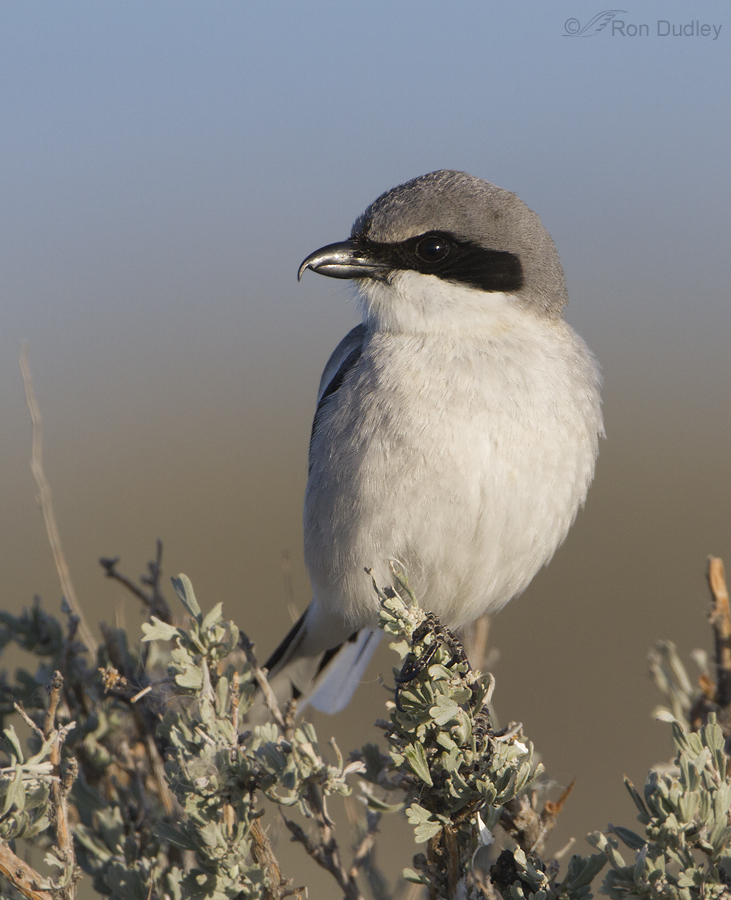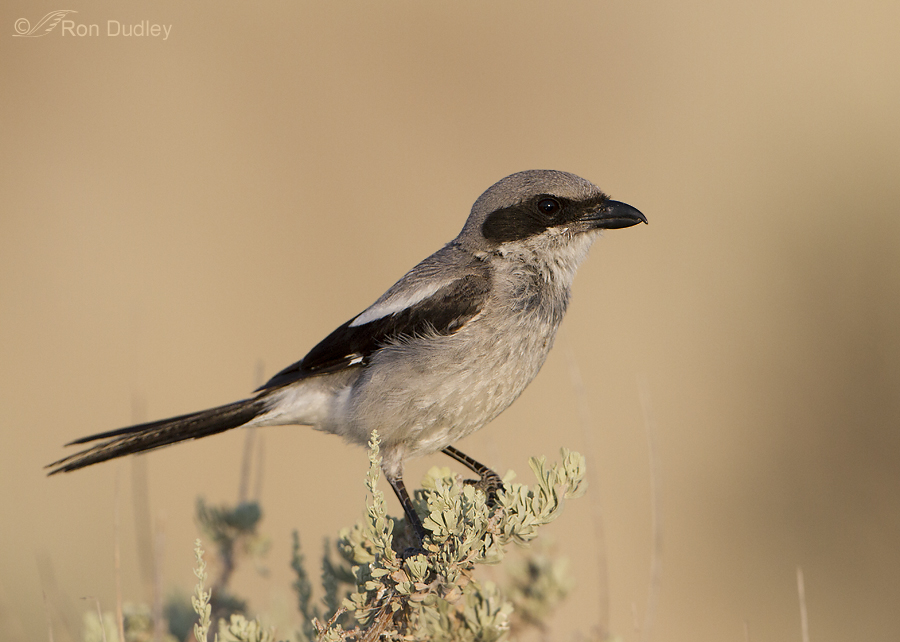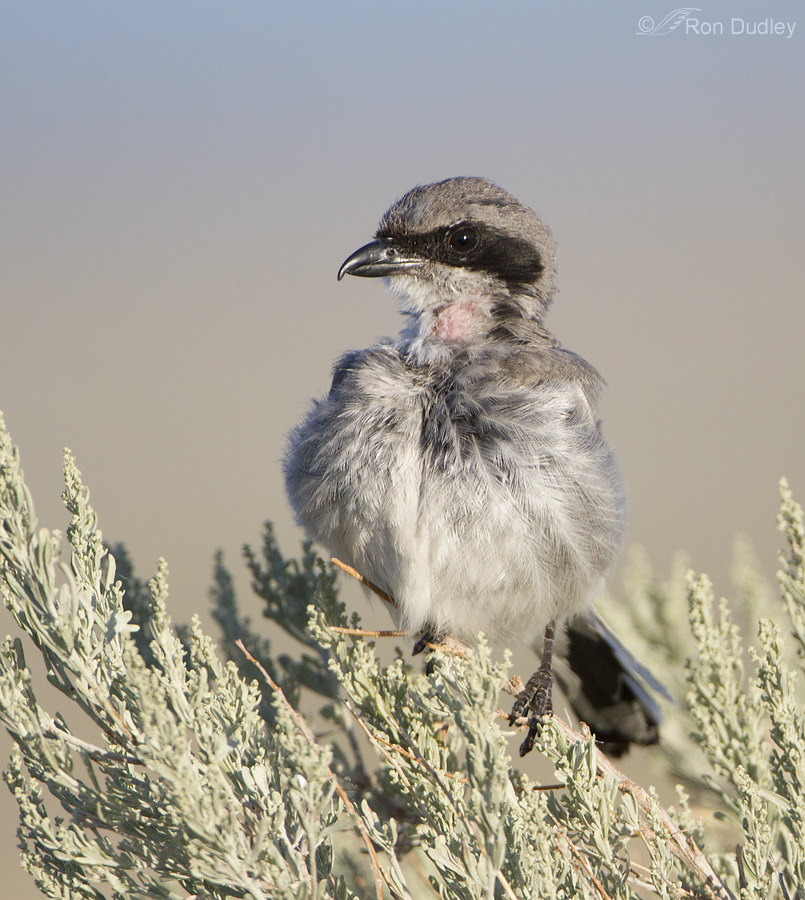I’m confused about a color change I’m seeing in Loggerhead Shrikes.
1600, f/7.1, ISO 640, 500 f/4, 1.4 tc, natural light, image taken 4/26/13 on Antelope Island
For most of the year the adults I see have a white or pale ventral surface (belly, breast and sides) which is exactly as described in the field guides and other resources I have access to.
2500, f/6.3, ISO 640, 500 f/4, natural light, image taken 7/3/13 on Antelope Island
But beginning in about early July there’s a fairly dramatic change that is not addressed in my field guides. That white plumage turns significantly darker and an almost black area on the upper breast appears. This is about the time they’re fledging chicks around here and when I first noticed this several years ago I wondered if the birds were simply becoming “dirty” as they scurried around trying to feed and care for those very demanding youngsters. But now I’m pretty sure that’s not the case.
All of the adult Loggerhead Shrikes I see go through this change to some degree or another.
3200, f/5.6, ISO 640, 500 f/4, 1.4 tc, natural light, image taken 7/14/13 on Antelope Island
Here’s another (pretty silly looking) example. This is also the time of year when these birds are molting so I wondered if I was somehow seeing black skin (some birds do have black skin) through very skimpy plumage that time of year and I was somehow mistaking it for black feathers. But as you can see in this preening, molting adult, their skin is pink.
The only other explanation I can think of is that the white feathers of these shrikes turn very dark when they are “worn” just before molting. I can’t think of any reason for that happening though and I’m dubious.
So, I’m very curious about two things: What’s causing this color change and why is it not mentioned or illustrated in any of my field guides or other resources?
Any thoughts? Perhaps I’m missing the obvious. Won’t be the first time…
Ron
Note: I’m on the road again for a few days and I’ll have no computer access so I won’t be able to respond to any comments in a timely fashion, though I do enjoy reading those comments in the email notifications I get on my phone.





The theory of worn plumage is certainly a good possibility. Loggerhead Shrikes are also known to molt twice a year, a “prenuptial” molt in the spring and a second molt after the breeding season and prior to migration. Very interesting observation!
I’m impressed by the things you notice Ron. Wearing to dark is a topic I’ve been discussing lately with friends. I’ve noticed it in a few gulls lately, and also in the Hoary Redpolls I’ve been looking at. Hoary Redpolls are supposed to be a very pale bird, compared to the Common Redpoll. All the birds I’ve seen have been fairly dark, with broader than normal streaking, but they are obviously Hoary’s. After discussing this we came to the conclusion that they are worn birds, and not many people see them this way in summer, so it’s not really discussed. Wearing to dark? Seems counter-intuitive to me at first, but as someone stated above, I think in feathers with low pigments, the feather edge wears away resulting in a dingy appearance coupled with exposing the down layer. It appears dark. Who knows, but the fun is in noticing and wondering about all the odd things that aren’t really in any literature. It’s really great to see you bringing up stuff like this, Ron!
As always I am receiving avian education here. Stunning photos, and a fascinating commentary. Thank you Ron for facilitating this – and thank you to all the informative commentators.
According to the (excessively detailed!) plumage description in Birds of North America (http://bna.birds.cornell.edu/bna/species/231/articles/appearance:
“Chin and throat white; breast and flanks smoke gray, each feather with 2 dusky bars 2.0 mm apart; belly and undertail-coverts white with subterminal dusky bars on median undertail-coverts in some birds”
Just wondering if with the molt, as Brian suggested, the tips wear down and you are seeing these ‘dusky bars’?
Hey Ron,
I’m pretty sure I know what’s going on here. I think that a combination of wear and/or absence of feathers is creating gaps in the plumage, exposing the darker bases of the feathers that we don’t usually see. If you pick up body feathers off the ground, you’ll often notice that the color that you see on the bird is usually limited to the feather tip, with a darker base. This is well illustrated in Bird Feathers by Scott and McFarland (http://www.amazon.com/Bird-Feathers-American-Species-Ornithology/dp/0811736180 ), a guide that while flawed is often very useful. I’ll email you a picture of a Sage Thrasher in the same condition.
I’ve seen some interesting variations in some of the birds that come to our feeder…a nuthatch with a broad white band across the ends of this tall feathers (it’s usually very narrow), an incredibly bright red juvenile cardinal (much brighter red than usual and deeper brown on the back), and a blue jay with long, very fluffy upper leg feathers (he looked like he was wearing pantaloons). Some of our Jays have darker, “dirtier” looking breasts than usual.. I don’t remember seeing this before, but it may be just my memory messing up. I’m also hearing some strange calls I’ve never heard before from some of these birds. These differences have been unusual enough to catch my attention.
Wonderful shots and really interesting. I would love to know what the answer is. Thanks for sharing these comparative shots.
Charlotte